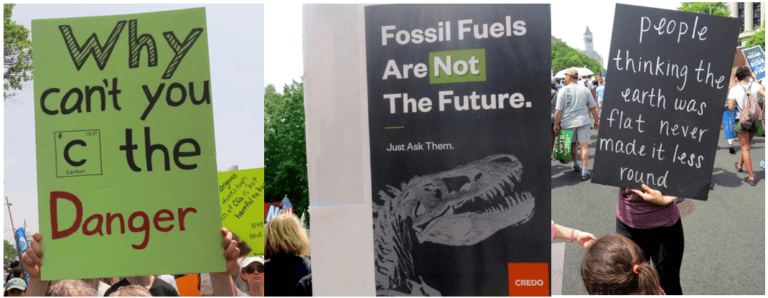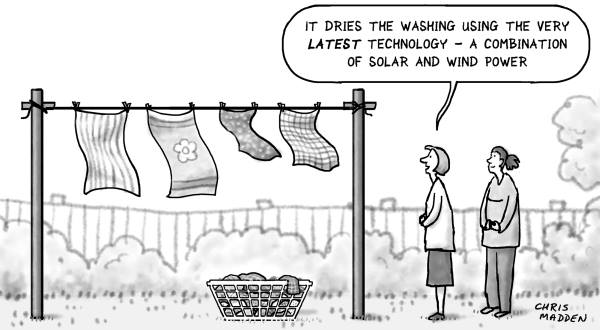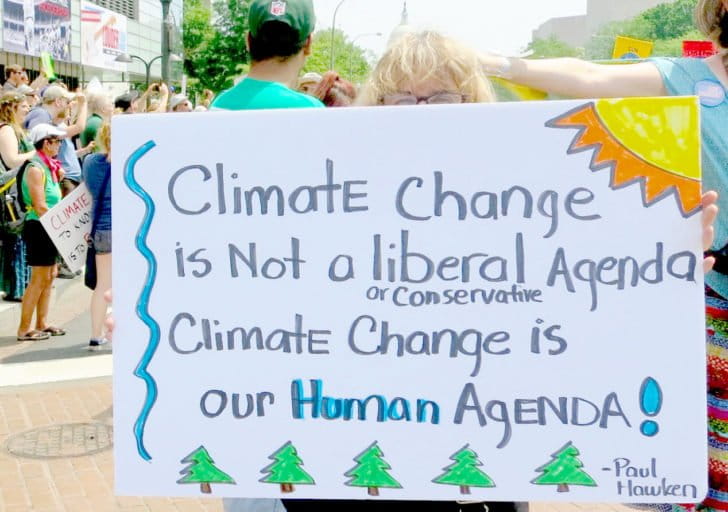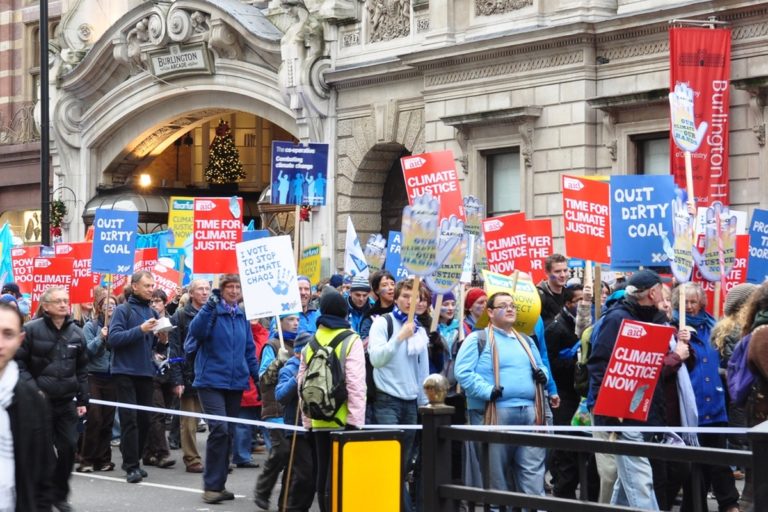- Tens of thousands of people participated in the People’s Climate March on April 29th to demand policies that help reduce greenhouse gas emissions, respect science, and apply technology to limit the damage caused by climate change.
- Major technological breakthroughs—such as better city designs, more efficient storage batteries, and power plants that capture CO2 already in the atmosphere—as well as expansion of existing technologies, are needed to reduce the negative impacts of climate change.
- Experts add: Political and societal will that promotes expanded use of climate-friendly technology at a massive scale are critical to achieving climate change reduction goals.
Just one week after thousands of people marched at Earth Day events across the globe to support science and research, over 200,000 more took to the streets of cities worldwide calling for government and corporate action that reduces, rather than intensifies, the impacts of climate change.
Marchers in Washington, D.C. were upbeat yet frustrated with proposed changes in U.S. policies that favor fossil fuel production, cut funding for scientific research, and leave human and wildlife communities vulnerable to environmental change.
“Defending and strengthening climate progress like the Paris Climate Agreement and the Clean Power Plan is one of the top reasons why so many people turned out for the march on April 29th,” said Keya Chatterjee, Executive Director of the U.S. Climate Action Network, “We marched to keep up the pressure on the Trump administration to stay in the Paris Agreement, strengthen the climate progress we’ve made, and keep pushing forward in our efforts to create a clean energy future that works for all.”

The irony of Saturday’s record-high temperatures were not lost on the protesters. One band in attendance, wearing green hardhats, played the song “Hot, Hot, Hot,” an attempt to add humor to an otherwise urgent message.

What is technology’s role in establishing a cleaner planet?
Continued technological innovation plays an obvious, critical role in reducing fossil fuel consumption. In an interview with The Huffington Post, Edward A. Parson, faculty co-director of the Emmett Institute on Climate Change and the Environment at the University of California, Los Angeles, said that energy technology is fundamental to reducing the impacts of climate change. “You can understand climate change as a mostly technical problem to which there is a mostly technical solution,” he argued.
The big problem, said Parson, is our use of fossil fuels for energy and transportation. We need to increase the efficiency of our energy use, reduce atmospheric emissions from fossil energy use, and target non-CO2 greenhouse gases from industrial and agricultural activities.
Solutions include clean renewable energy, better energy storage and improved nuclear power. “The technologies that are needed to move to a climate-safe society, many of them are already available or close to development,” Parson said. The World Economic Forum identified five such innovations that address humans’ love of travel, independence, and eating meat through:
- Fusion as an alternative source of nuclear power
- More efficient batteries and charging mechanisms for powering vehicles’
- Manufacturing plants that capture carbon and use it to produce fuel;
- Lab-grown meat to replace cattle, a source of greenhouse gas methane, as well as the major driver of Amazon deforestation; and
- Smarter city designs that use modern materials, sensors, and models to reduce waste and costs for residents.

Nevertheless, switching from fossil fuels, which form the bulk of energy consumption globally, will still be a slow process, even as alternative power sources and storage become cheaper and more efficient. “It’s a huge change that has to happen,” Parson said. “A lot of what has to happen to change the energy system isn’t discovering the brilliant new breakthrough technology that’s going to make it all better. It’s rolling new, better technologies out through the whole system and getting them deployed and used.”
Policies needed to support and distribute innovative technologies
Parson recognized that policies that encourage investment in “good” energy—such as renewables—are needed to make this happen. For example, carbon taxes or incentives that make energy production from burning fossil fuels more expensive than using other sources encourage corporations to move away from them toward cheaper, easier means. But, said Parson, “the only place they can reliably come from is policy and regulation deployed by government.”

Making other energy sources—including renewables such as solar, wind, geothermal, hydro, and nuclear (including fusion) power—cheaper and more efficient while limiting impacts on human and ecosystem health will be essential if we are to reduce greenhouse gas emissions. Carbon dioxide and other greenhouse gases in the atmosphere trap radiation from the sun and cause the atmosphere to warm the planet’s surface more than would naturally occur. As their atmospheric concentrations increase, the warming effect of this “greenhouse” does, as well.
Various experts acknowledge the need to not only slow emissions, but also remove carbon from atmosphere. Moreover, the increased reliance on carbon removal in building climate change models may mask the need to complement technological development with other actions, such as policy incentives and behavior changes, that these models’ findings indicate are needed to avoid the worst negative impacts of a changing climate.

“There are almost no business cases for carbon removal right now,” notes Oliver Geden, a climate analyst and head of the European Union division at the German Institute for International and Security Affairs. In other words, he says, emitting CO2 into the air costs companies next to nothing, so they have no financial incentive to stop emitting, let alone pay to clean up the air by building power plants with CO2 capture and storage capacity.
Kevin Anderson, a professor of energy and climate change at University of Manchester, UK, believes that revolutionary changes in how we both consume and produce energy are required to reduce greenhouse gas emissions sufficiently to avoid a 2oC rise in global temperature. He adds that the scope of necessary psychological and behavioral breakthroughs (willingness to change our lifestyles) is greater than even many scientists are able to accept and something we cannot ignore. Decreasing carbon emissions without sacrificing the welfare of poor communities worldwide puts even greater pressure on the few rich countries responsible for the bulk of emissions.
Establishing economic incentives or mandates to reduce CO2 emissions, in turn, requires political and societal backing, including funding, enabling environments, and information sharing. Without this backing, even major technological breakthroughs won’t be enough. Equally substantial government financial and political support are needed to promote and deploy new technologies at the scale needed to significantly slow climate change.
Finding political and societal will to address the challenge

Nevertheless, the Trump Administration is shifting the US government’s emphasis toward fossil fuel production and away from acknowledging the critical role it plays in understanding and addressing drivers of climate change.
How does the public inspire political will? By communicating with leaders, individually—through petitions, letters, calls, and face-to-face communication (most effective)—and jointly, through marches such as the People’s Climate March.
In this weekend’s march, demonstrators shouting “Shame!” and “Hey Hey, Ho Ho, Donald Trump has got to go” at the President and his Environmental Protection Agency Administrator Scott Pruitt, who has repeatedly fought the EPA over regulations to curb greenhouse gas emissions, shared the scene with others warning “Protect your Mother, you’ll never have another”.
In the absence of government support, some corporate leaders have initiated funding schemes to promote technology-driven solutions and invested in promising systems to produce greener, more efficient fuels, agriculture, buildings, vehicles, and power plants.

The DC climate marchers called for policies to promote these types of systems and minimize environmental costs on communities. May Boeve, Executive Director, 350.org, one of the climate march steering committee members, said of the march, “…we are mobilizing in the masses to fight for the bold solutions we need. We will present our vision to replace the fossil fuel industry with a 100% clean energy economy that works for all.”

Banner image — Seen at the DC climate march: a traditional quilt made in communities in hydraulic fracturing (fracking) regions of Pennsylvania. Photo credit: Sue Palminteri














